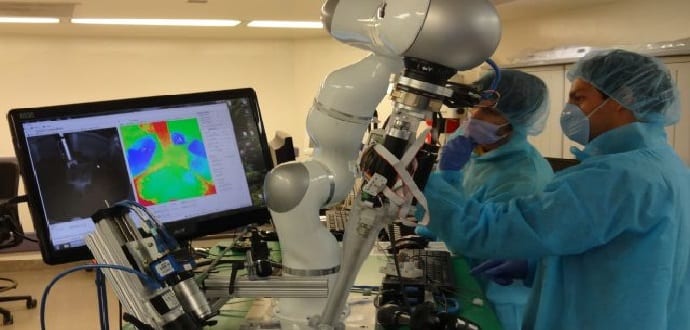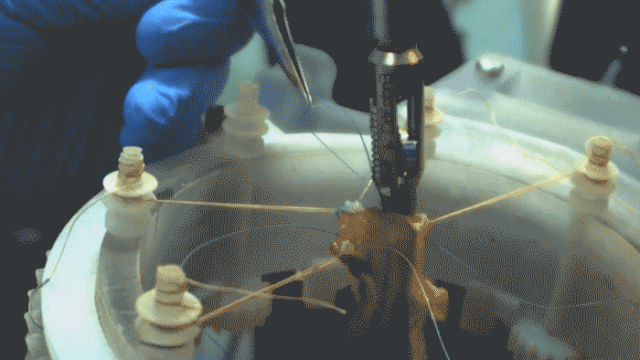First autonomous robot to operate on soft tissue and it does it better than human surgeons
The surgical bot named STAR, or Smart Tissue Autonomous Robot, on Wednesday performed the world’s first autonomous, soft-tissue surgery. It is the first time that a surgical robot has completed a portion of an operation in living soft tissue by stitching together separate pieces of the bowel in pigs without any human guidance.
STAR is the creation of a team of medical researchers and computer scientists led by Dr. Peter C. Kim, Vice President and Associate Surgeon-in-Chief, Sheikh Zayed Institute for Pediatric Surgical Innovation at Children’s National Health System in Washington D.C.
The inventors of STAR don’t claim that robots can replace humans in the operating room or clinic trial anytime soon. In fact, they see the accomplishment as a proof of concept—both for the specific technologies used and for the general concept of “supervised autonomy” in the OR.
“Even though we surgeons take pride in our craft at doing procedures, to have a machine that works with us to improve outcomes and safety would be a tremendous benefit,” Dr. Kim said.
The study published in the journal Science Translational Medicine, described the demonstration as a key achievement in efforts to move toward autonomous robotic surgery. This technology removes the surgeon’s hands from the procedure, instead utilizes the surgeon as supervisor, with soft tissue suturing autonomously planned and performed by the STAR robotic system.
“Our results demonstrate the potential for autonomous robots to improve the efficacy, consistency, functional outcome and accessibility of surgical techniques,” said Dr. Kim. “The intent of this demonstration is not to replace surgeons, but to expand human capacity and capability through enhanced vision, dexterity and complementary machine intelligence for improved surgical outcomes.”
Dragan Golijanin, director of the Minimally Invasive Urology Institute at the Miriam Hospital, an affiliate of Brown University, who was not involved in the trial, said “It’s one step forward.”
Soft tissues are the tissues that connect, support or surround other structures and organs of the body such as tendons, ligaments, fascia, skin, fibrous tissues, fat, synovial membranes, muscles, nerves and blood vessels. Currently, more than 44.5 million soft tissue surgeries are performed in the U.S. each year.
STAR has performed several supervised (but unguided) surgical procedures in which it stitched together two severed segments of bowel intestine in living, anesthetized pigs. The operation is called intestinal anastomosis, in which a piece of intestine that’s been cut through is stitched back together. Not only did the pigs survive the successful operations, but STAR was found to have far outperformed manual open surgery, laparoscopy surgery, and the next best robotic assisted surgery.
The robot did need a little help. In about 40 percent of its trials, the researchers intervened to offer guidance of some kind. However, in the other 60 percent of trials, the researchers left STAR to do what it would, and they made sure that the robot was placing the sutures in the correct place the rest of the time.
“Current robotic surgery is ‘teleoperated’, [meaning that] every step and every movement of the robot, is directed by the surgeon,” says Axel Krieger, a robotics expert with the team at Children’s National Health System. “Our innovation is really to make this more autonomous, so that you don’t have to direct every motion.”
To create the STAR, the researchers started with an existing robot arm from KUKA Robotics and introduced two imaging innovations to overcome the problems enforced by operating on soft tissue. They enabled the robot to track shifting shapes in 3-D and added a function, defined almost like night vision that helped the robot tease apart which tissue to stitch and which to leave alone.
“Having a tool like this, and by making the procedures more intelligent, we can have better outcomes for patients,” said Dr. Kim.
With their system, the researchers from Children’s National and Johns Hopkins University programmed the robot with skills taken from top surgeons, they said. An algorithm directed STAR where it should insert the needle during sutures, how much space should be left between each stitch, and how tight to pull the suture.
About half a dozen patent applications for the technology have been filed by the researchers who hope to see it commercialized in the future. They said the soft-tissue surgeries that could first be done autonomously include removals of the gallbladder and appendix. With driverless cars coming into our lives, maybe one day surgical robots could take over human surgeons.


